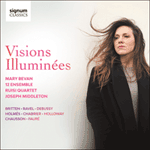
Welcome to Hyperion Records, an independent British classical label devoted to presenting high-quality recordings of music of all styles and from all periods from the twelfth century to the twenty-first.
Hyperion offers both CDs, and downloads in a number of formats. The site is also available in several languages.
Please use the dropdown buttons to set your preferred options, or use the checkbox to accept the defaults.

| Mary Bevan (soprano), 12 Ensemble» More |
After its dreamy opening, Wagner’s Träume progresses to a more strident mood in its middle section which encompasses the passionate and the visionary. Chabrier’s song is a big one with remarkable climactic moments, but he is content that it should stay within the more personal boundaries of a love-song hymning the lineaments of gratified desire. The composer contrives a more ‘swung’ triple metre by sliding imperceptibly back and forth between 3/4 and 6/8. At the beginning of the song we hear the vocal line slowly climbing the stave moving in two dotted crotchets a bar; when quavers are introduced we hear these, according to the stresses of the text, sometimes in 3/4 (as three groups of two quavers – as at ‘des menuets’), and sometimes in 6/8 (as two groups of three). This gives the music an impression of two speeds within a single tempo. This feeling of dragging behind the beat and then tumbling forward – restraint followed by the loosening of stays – contributes greatly to the eroticism of the music.
From the singer’s very first notes (the established key of C major contradicted by an A flat and B flat in the rising vocal line) this song shows that Chabrier had mastered every trick in the book in terms of Wagnerian chromatic harmony. And yet Tes yeux bleus still sounds French; in the same way, Debussy’s early Mallarmé setting Apparition, composed at more or less the same time, also remains irrefutably French despite a debt to Wagner. In Debussy’s case Massenet’s influence is a large part of the antidote; and Chabrier’s own other, more rumbustious, self saves him from total hero-worship. Despite his veneration for Wagner, Chabrier has a way of embracing this composer and rejecting him at the same time. There is much in this music of which Wagner would never have approved (Cosima found Le Roi malgré lui disgustingly vulgar) but these are the very passages which chabriéristes pounce on with glee. The long sensual plunge of the vocal line over a pool of acquiescent pianistic sonority at ‘Lorsque vers moi tu remuais’, or the similar setting of ‘Tendrement tu m’insinuais’, are surely amongst the most rapturous (and suggestive) in the composer’s music.
This is the only song of Chabrier’s that exists in an orchestration for strings – perhaps further proof of its Wagnerian inspiration. The voice has to be supported by a shimmer of sound rather than the plodding repeated chords of an unimaginative pianist. But in Extase Duparc had already proved that the piano can be made to murmur in loving complicity with the voice, and one has to adopt the same silken touch here – except where fragments of melody are pricked out by an eloquently singing little finger. This is particularly true of the postlude where Chabrier allows himself further reminiscences of the Liebestod. Chabrier has the most sophisticated familiarity with Wagner’s harmonic world, indeed his whole œuvre, but he never loses his own individuality. Duparc manages the same thing of course, and so does Hugo Wolf in a song like Bedeckt mich mit Blumen. All three were slaves to Wagner but, in winning their freedom from their former master, achieved greatness as song composers in their different ways.
from notes by Graham Johnson © 2002
 Visions illuminées Visions illuminéesA beautiful album of French songs, from Augusta Holmès' largely forgotten cycle of 'Sérénades' from 1883 through to Benjamin Britten's 1938 discovery of the prose-poetry of the French symbolist Arthur Rimbaud, and taking in Robin Holloway's newly ...» More |

